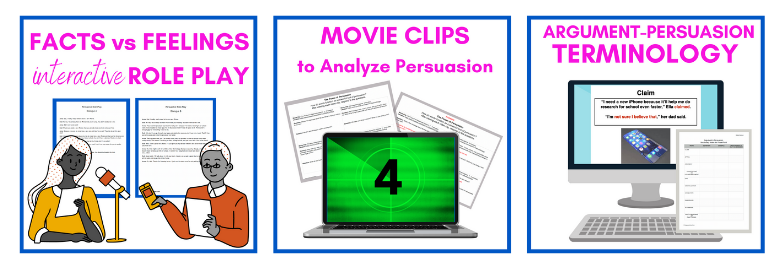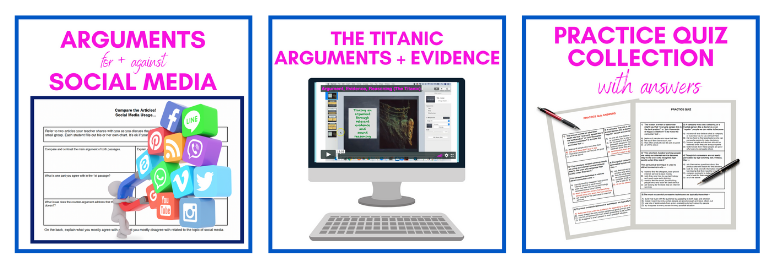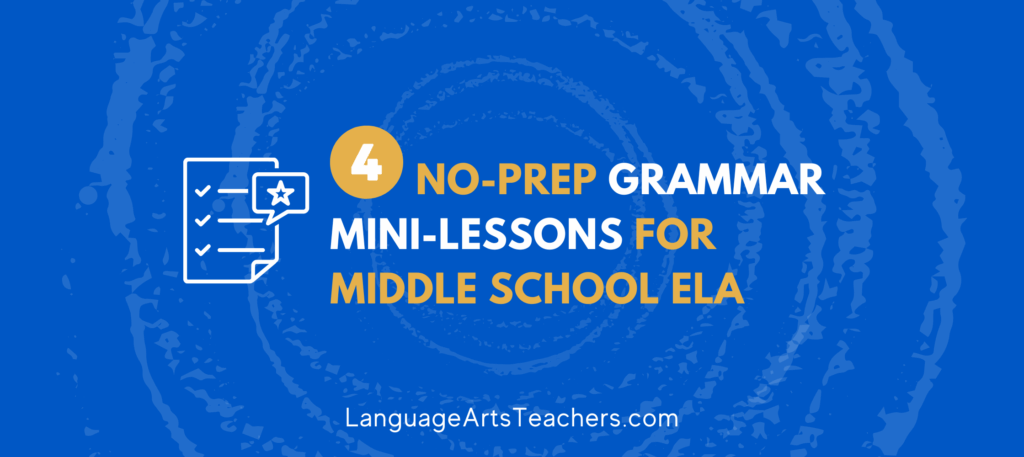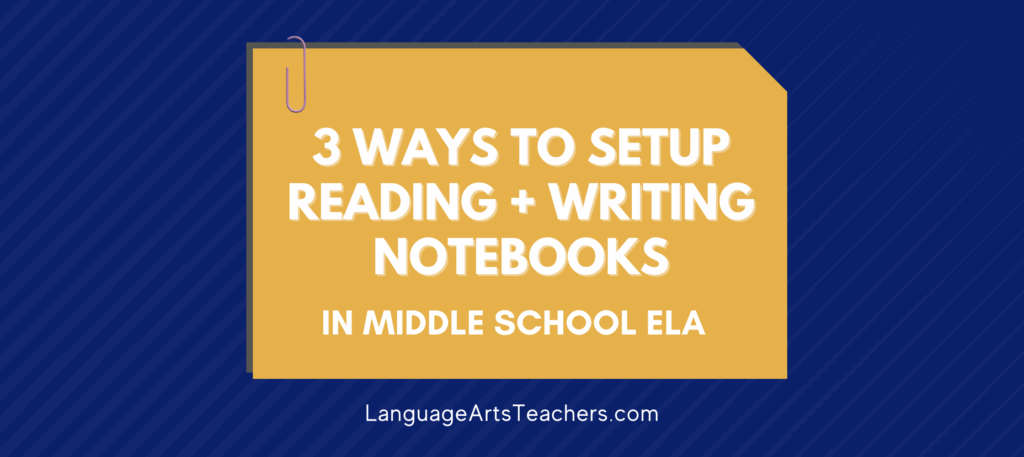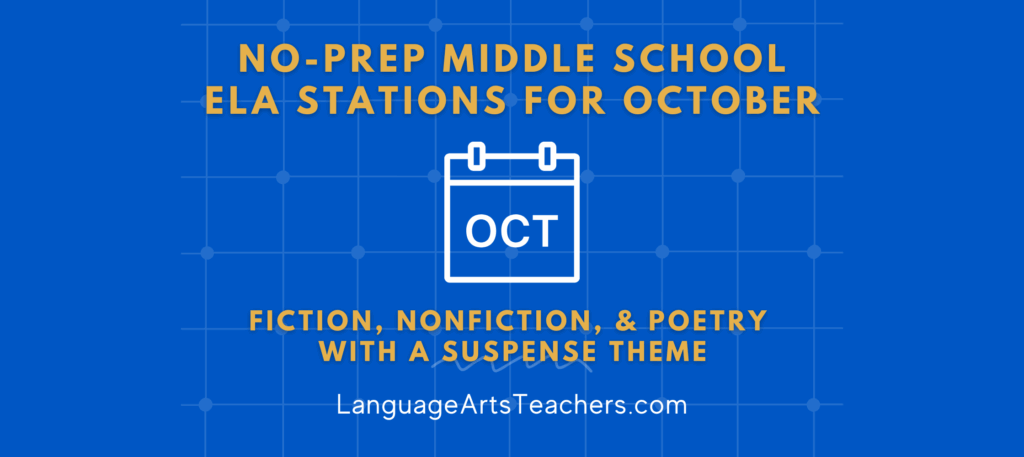Locating or creating resources to support elements of argument and persuasion is time-consuming and frustrating, especially when you’ve already taught the concepts and need more materials!
I’ve created a collection of my top 10 mini-lessons and learning experiences (I’ll share them with you in a sec) so you can teach, re-teach, review, or even introduce the most common argument and persuasion concepts in another way (sometimes students finally ‘get it’ when they simply have a chance to see or hear similar information in a different way).
Note that I do realize “persuasion” and “argument” are not exactly the same thing; however, I have found that when students struggle with the more advanced concepts of argumentation, it typically goes back to gaps in understanding the basic elements of persuasion from years past. Therefore, I have included common elements of persuasion AND argumentation to help you have choices when it comes to meeting your students where they are.
Ok, so here are my Top 10 mini-lesson topics that I personally use (and share with other teachers like you) to review, reteach, practice, and close gaps around objectives related to argument and / or persuasive reading and writing . . . Feel free to use this list as a reference guide for creating your own go-to mini-lessons, or hang with me and I’ll provide access to these exact items so you don’t have to do it all yourself!
You can do these in any order, but giving students a fresh start with Mini-Lesson #1 where they all get to begin on the same foundational level is my preferred approach. . . It’s a role play activity that is highly engaging (becasue it’s so relateable to them personally) where they take on the role of parent and child.
Here’s the situation in that very first lesson, which you can totally set up in your class yourself, or you can use mine > > CLICK HERE for MINE < <
A child wants a new iPhone and the parent says no way! In this lesson, there are two versions of the conversation where first the child whines and complains about why he needs a new iPhone. It’s not persuasive at all (though it’s very relatable and funny for students) and the parent easily says no. The next part of the lesson is the same child, the same parent, and this time the child uses logical, factual reasons as to why a new iPhone is a necessity for him. Students LOVE seeing the way the dialogue plays out between the child and the parent. This lesson is a prime opportunity to talk about persuasive concepts like knowing your audience, using logical reasoning supported by specific examples in order to present a solid case.
And finally, this 15 minute role-play lesson ends with discussion questions that invite students to revisit those basic elements of persuasion. It’s the building block for all the other lessons in the series laid out below, and it’s a lesson your students will remember!
Mini-Lesson Set #1: Facts vs. Feelings Interactive Role Play with Discussion Questions
→ This is the role play summary I explained above. The goal here is to have students practice (and act out) examples of weak persuasion and examples of solid persuasion, keeping their audience in mind and thinking about logical arguments and counter-arguments in a respectful way.
Mini-Lesson Set #2: Movie Clip Collection to Analyze Persuasion + Q’s + Answer Key
→ I love using movie clips (including the same scene from two or more different versions of a movie) to talk about persuasive elements along with tone, gestures, movement, etc. so students get an overall view of what’s involved in the finer points of argument and persuasive techniques. Role play and movie clips make the concepts tangible, relatable, meaningful, and memorable to them before diving deeper into the skills. Some of my favs for this are found on YouTube, like. . .
- A very short excerpt from The Pursuit of Happyness (3 min)
- This brief scene from The Blind Side (4 min)
- Even this selection from Kid President (3 min)
- And this short compilation of several movie speeches (3 min)
Mini-Lesson Set #3: Argument / Persuasion Terminology Review with Guided Notes
→ I have a PDF / Power Point mini-lesson full of images, simple definitions, and actual examples to bring home the domain-specific vocabulary students need to use when analyzing argumentative texts. There’s also a note-taking page I’ve included so students have a resource to refer back to throughout all the lessons and learning experiences they encounter as part of the bigger unit. The best part is that I created the mini-lesson so it can be used as a whole-class activity or independently via Google Classroom if that’s what you use. You’ll notice I don’t even start talking about the “official” vocabulary until this point where we’re at the 3rd lesson in the 10 lesson set of argument / persuasion. I do that for good reason! Through the other two mini-lessons I already talked about, students will have already encountered some of the terms in very natural, built-in ways, which sets them up for success. By the time you get to the “Let’s-go-over-some-important-terms-for-this-unit,” they’ll already have a working knowledge that they can draw from.

Mini-Lesson Set #4: Emotional / Factual Appeal with Examples + Practice
→ At this point, the lesson here puts into practical application the difference between using emotions and feelings as persuasive techniques vs. using facts and logic as persuasive techniques. After this particular mini-lesson, it’s also fun to go back to the role play iPhone lesson or even the famous movie clips lesson to specifically look for (and discuss) emotional / factual appeal because NOW you’ll also be able to talk about those techniques in a deeper way.
Mini-Lesson Set #5: Analyze the Argument: Article + Discussion Task Cards
→ In this lesson, students refer to an online article about how kids have the power to be some of our most creative problem-solvers. Click here to check it out for yourself! Related to that article, I first ask students to identify examples of some of the argument / persuasion terms from mini-lesson #3. Then we move into open-ended discussion questions where students are encouraged to provide their own opinions, but then they have to support those opinions with valid text evidence from the article (or else they have to adjust what they *thought* they believed as they look at what the evidence in the article actually shows us). I use questions like:
- In what way do you see kids as real-world problem-solvers?
- Do you think people have to be a certain age to start solving important problems in the world? Explain why or why not.
- Why do some adults think kids can’t do anything and others see kids as the future?
- What problem do you consider to be an important issue in the world (and how would you go about solving it?)
Mini-Lesson Set #6: Argumentative Writing Support Stack Created with Padlet
→ Whether you teach writing or not (since some schools divide the reading and writing between two separate teachers), there’s something powerful about having students write out their own opinion pieces using the argument / persuasive techniques they’ve been learning about. I have a Padlet resource for students (it’s such a time-saver for teachers, too) where they are provided ideas for topics, examples and how-to’s for the intro, the body, and the conclusion (and other things in between like transitions, etc.). You can make such an assignment as formal or as informal as you wish! It’s a great way to get kids writing about their own ideas rather than merely reading about other people’s ideas.
Mini-Lesson Set #7: One Topic–Two Authors-Opposing Viewpoints + Q’s + Answer Key
→ This is a fun lesson where I present two sides of the same topic: Homework! One article is written from the point-of-view of a student who actually like the benefits of homework and is all for it. The other paired article is written from the point of view of a parent who despises the homework her child brings home and who has her own reasons for being “anti” homework. Of course there are discussion / multiple choice questions to go along with this lesson, but my own students always find it interesting that it’s the student who is “pro” homework and the parent who is “anti” homework. It’s not what they would typically expect, and we have some pretty good conversations around that to where they often don’t even realize they’re deep into analysis!
Mini-Lesson Set #8: Arguments For & Against Social Media Usage + Discussion Q’s
→ Social media isn’t going anywhere, and it’s interesting to present students with some pros and cons about its role in our lives. Pretty much anyone born after 2005 can’t remember a time when we didn’t rely on social media every second of the day. It’s eye-opening for students to explore the pros and cons and I’m telling you–I’ve had some surprisingly deep conversations even with 6th graders about our dependence and emotional turbulence that comes from social media. It’s an enjoyable lesson, and it’s not about right or wrong–it’s simply about what is reality and what persuasive techniques two articles are using to form their arguments.
Mini-Lesson Set #9: The Titanic: Arguments + Evidence (Video based instruction)
→ Students, even the most reluctant ones, still seem fascinated by the tragedy of The Titanic. For this mini-lesson, I’ve curated several videos and article selections and linked to them online so students can explore the facts and the theories (which brings in persuasive elements of the argument around what *really* happened). You can locate such videos and articles yourself–they’re all over the Internet in abundance–or you can use the ones I’ve found and organized that are my favorites > > CLICK HERE < < to access the entire lesson set which also includes the Titanic lesson as well as ALL the lessons I’ve described here (and mini-lesson sets for the other reading and writing genres you have to teach throughout the year).
Mini-Lesson Set #10: Practice Quiz Collection – Great for Test Review!
→ You can use this quiz collection as station work for extra practice, or for actual quizzes throughout the course of your argumentative unit… You could even combine them as a short test for your students. There are 2 – 3 pages here, each with four multiple-choice questions that mimic the way students will likely encounter questions in formal testing scenarios. An answer key is included, too.
Ideas for Using These Mini-Lesson Sets:
*** Introduce or re-introduce elements of persuasion and argumentation
*** Station / center work >> Click Here to Access my FREE training on setting up & running stations
*** Test prep or review >> Click Here to access my FREE training on engaging test prep strategies
*** Extra resources for tutoring or additional support / intervention
Each mini-lesson set contains a different focus as listed above, but each one also can be used to meet other standards or teaching moments as well. These sets are simply to get you started, or to serve as support and practice, and you can insert all kinds of your own teachable moments as you go. These are designed as a jumping off point for in-class discussion (or could be done independently and then used as the basis for further class or small group discussion).
Please note that the standards listed are covered throughout the various sets of mini-lessons, not necessarily all of them are in each set at once (hope that makes sense). In other words, you’ll hit those standards through the course of all the lessons collectively, which makes this set really helpful for test prep, review, spiraling of concepts, etc.
CCSS > > You’ll be able to meet both CCSS and TEKS standards in the Non-fiction Expository Paired Passages I’ve put together as part of the Middle School ELA Essentials Bundle.

I hope all that helps! If it even helps your students a little bit while also saving you major time throughout the year, then that’s something to be celebrated😊
Click Here to grab your Middle School ELA Essentials Bundle at 80% off the normal price – It comes with the resources I mentioned already PLUS 100+ mini-lessons covering all the most important, most essential genres and concepts so you can jump off the struggle bus 🚌 and find confidence, clarity, and creativity again in teaching!

